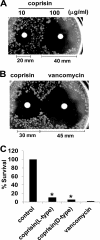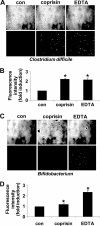The insect peptide coprisin prevents Clostridium difficile-mediated acute inflammation and mucosal damage through selective antimicrobial activity
- PMID: 21807975
- PMCID: PMC3186999
- DOI: 10.1128/AAC.00177-11
The insect peptide coprisin prevents Clostridium difficile-mediated acute inflammation and mucosal damage through selective antimicrobial activity
Abstract
Clostridium difficile-associated diarrhea and pseudomembranous colitis are typically treated with vancomycin or metronidazole, but recent increases in relapse incidence and the emergence of drug-resistant strains of C. difficile indicate the need for new antibiotics. We previously isolated coprisin, an antibacterial peptide from Copris tripartitus, a Korean dung beetle, and identified a nine-amino-acid peptide in the α-helical region of it (LLCIALRKK) that had antimicrobial activity (J.-S. Hwang et al., Int. J. Pept., 2009, doi:10.1155/2009/136284). Here, we examined whether treatment with a coprisin analogue (a disulfide dimer of the nine peptides) prevented inflammation and mucosal damage in a mouse model of acute gut inflammation established by administration of antibiotics followed by C. difficile infection. In this model, coprisin treatment significantly ameliorated body weight decreases, improved the survival rate, and decreased mucosal damage and proinflammatory cytokine production. In contrast, the coprisin analogue had no apparent antibiotic activity against commensal bacteria, including Lactobacillus and Bifidobacterium, which are known to inhibit the colonization of C. difficile. The exposure of C. difficile to the coprisin analogue caused a marked increase in nuclear propidium iodide (PI) staining, indicating membrane damage; the staining levels were similar to those seen with bacteria treated with a positive control for membrane disruption (EDTA). In contrast, coprisin analogue treatment did not trigger increases in the nuclear PI staining of Bifidobacterium thermophilum. This observation suggests that the antibiotic activity of the coprisin analogue may occur through specific membrane disruption of C. difficile. Thus, these results indicate that the coprisin analogue may prove useful as a therapeutic agent for C. difficile infection-associated inflammatory diarrhea and pseudomembranous colitis.
Figures




Similar articles
-
Insight into the antimicrobial activities of coprisin isolated from the dung beetle, Copris tripartitus, revealed by structure-activity relationships.Biochim Biophys Acta. 2013 Feb;1828(2):271-83. doi: 10.1016/j.bbamem.2012.10.028. Epub 2012 Nov 6. Biochim Biophys Acta. 2013. PMID: 23137439
-
Synergistic effect and antibiofilm activity between the antimicrobial peptide coprisin and conventional antibiotics against opportunistic bacteria.Curr Microbiol. 2013 Jan;66(1):56-60. doi: 10.1007/s00284-012-0239-8. Epub 2012 Sep 30. Curr Microbiol. 2013. PMID: 23053486
-
Analysis of anti-Clostridium difficile activity of thuricin CD, vancomycin, metronidazole, ramoplanin, and actagardine, both singly and in paired combinations.Antimicrob Agents Chemother. 2013 Jun;57(6):2882-6. doi: 10.1128/AAC.00261-13. Epub 2013 Apr 9. Antimicrob Agents Chemother. 2013. PMID: 23571539 Free PMC article.
-
Clostridium difficile bacteremia, Taiwan.Emerg Infect Dis. 2010 Aug;16(8):1204-10. doi: 10.3201/eid1608.100064. Emerg Infect Dis. 2010. PMID: 20678312 Free PMC article. Review.
-
Clostridium difficile infection.Annu Rev Med. 1998;49:375-90. doi: 10.1146/annurev.med.49.1.375. Annu Rev Med. 1998. PMID: 9509270 Review.
Cited by
-
Antimicrobial peptide-based strategies to overcome antimicrobial resistance.Arch Microbiol. 2024 Sep 23;206(10):411. doi: 10.1007/s00203-024-04133-x. Arch Microbiol. 2024. PMID: 39311963 Review.
-
Antimicrobial peptides and colitis.Curr Pharm Des. 2013;19(1):40-7. doi: 10.2174/13816128130108. Curr Pharm Des. 2013. PMID: 22950497 Free PMC article. Review.
-
The Insect Peptide CopA3 Increases Colonic Epithelial Cell Proliferation and Mucosal Barrier Function to Prevent Inflammatory Responses in the Gut.J Biol Chem. 2016 Feb 12;291(7):3209-23. doi: 10.1074/jbc.M115.682856. Epub 2015 Dec 11. J Biol Chem. 2016. PMID: 26655716 Free PMC article.
-
Perspectives in Searching Antimicrobial Peptides (AMPs) Produced by the Microbiota.Microb Ecol. 2023 Dec 1;87(1):8. doi: 10.1007/s00248-023-02313-8. Microb Ecol. 2023. PMID: 38036921 Free PMC article. Review.
-
Antimicrobial proteins in intestine and inflammatory bowel diseases.Intest Res. 2014 Jan;12(1):20-33. doi: 10.5217/ir.2014.12.1.20. Epub 2014 Jan 28. Intest Res. 2014. PMID: 25349560 Free PMC article. Review.
References
-
- Amit-Romach E., Uni Z., Reifen R. 2008. Therapeutic potential of two probiotics in inflammatory bowel disease as observed in the trinitrobenzene sulfonic acid model of colitis. Dis. Colon Rectum 51:1828–1836 - PubMed
Publication types
MeSH terms
Substances
LinkOut - more resources
Full Text Sources
Other Literature Sources
Medical
Molecular Biology Databases
Research Materials
Miscellaneous

